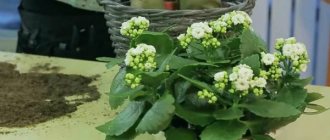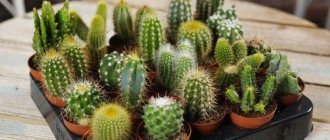Author: Elena N. https://floristics.info/ru/index.php?option=com_contact&view=contact&id=19 Category: Houseplants Published: February 20, 2019Last edits: January 11, 2021
- Care during flowering
- Growing from seeds
- Why do cacti turn yellow?
- Astrophytum
Cactus (lat. Cactaceae) belongs to the Cactaceae family, represented by perennial flowering plants. The family is divided into four subfamilies. The word "cactus" is of Greek origin. Carl Linnaeus introduced this name in 1737 as an abbreviation for "melocactus" (thistle) due to the spines with which representatives of the Cactaceae are covered. It is suggested that cacti evolved evolutionarily about 30-40 million years ago, and, despite the fact that fossil cacti have not yet been found anywhere, it is believed that the homeland of cacti is South America, and they spread to the northern continent not so long ago - no more than 5-10 million years ago. Thus, we can consider cacti to be plants of the New World. And today the habitat of the cactus in nature is South and North America and the islands of the West Indies. In addition to the American continent, the cactus plant can be found in natural conditions in Africa, Madagascar and Sri Lanka - they claim that cactus seeds were brought there by birds.
Planting and caring for cacti
- Flowering: depends on the species.
- Lighting: bright sunlight (south window sills).
- Temperature: in spring and summer - normal for residential premises; in winter, cooler conditions are desirable - 6-14 ˚C with regular ventilation and absence of drafts.
- Watering: moderate, as soon as the substrate dries. In cold or rainy weather, watering is not carried out even in summer. In winter, many types of cacti are watered once a month or not at all. In the spring, at the first signs of growth, spray the cacti with water, and when they begin to grow, carry out 2-3 lower waterings with water at a temperature of 28˚C to saturate the substrate with moisture. However, keep in mind: such baths are harmful to hairy and woolly species.
- Air humidity: low.
- Feeding: once a week during the period of active growth on pre-moistened soil with a weak solution of a mineral complex for cacti (Kadatsky mixture). In winter and during annual transplants into fresh substrate, cacti do not need feeding.
- Dormant period: from November to March or after flowering.
- Replanting: as needed, in spring, at the beginning of active growth. Young cacti are replanted annually.
- Reproduction: usually by children, but also by seeds.
- Pests: mealy root and mealy stembugs (hairy aphids).
- Diseases: dry and black rot, late blight, rhizoctonia, helminthosporosis, fusarium, spotting and viral diseases.
Read more about growing cacti below.
Group 4: how to care for a small cactus
Before caring for a small cactus, you need to know that they differ from the cacti described in group 1 and requiring standard care in their origin from high mountain regions. That is why they prefer a location that is light, but not very hot; they love a large difference between day and night, summer and winter temperatures, and also require a lot of fresh air.
Group 4 includes:
Lobivia
Rebutions
Highland Echinopsis (Pseudolobivia)
Sulcorebutia
Oreocereus
These plants wither in the summer behind the glass of a south-facing window that is too hot, but grow excellently in a bright, well-ventilated greenhouse or on an outside windowsill if there is sufficient protection from rain.
You can also try to grow these cacti on light south-eastern and south-western windows, however, you must take into account their need for a lot of fresh air.
In their high mountain natural habitats, sunlight is characterized by high levels of ultraviolet rays; since glass blocks most ultraviolet radiation, these plants grow much better when they can receive direct sunlight at least occasionally. In winter, these cacti must be kept in completely dry and cool conditions at a temperature of about 4-6°C. When kept dry, these cacti often tolerate small short-term night frosts. If these cacti overwinter in warm conditions, then there is a great danger of loose, unsightly growth, and very few flower buds are formed.
Botanical description
Many cacti and succulents have taken root in indoor culture and have been growing on our windowsills for hundreds of years. However, succulents and cacti are not the same thing: if all cacti are succulents, then not all succulents are cacti. We will tell you what the difference between them is, how to plant a cactus, how to grow a cactus, how to water a cactus correctly, how to care for a cactus at home and what methods are used to propagate cacti.
The cactus plant differs from succulents in the presence of an areola, a special organ that is a modified axillary bud with scales transformed into spines or hairs, although many varieties have both. Another difference between cacti and succulents is the structure of their flowers and fruits - part of the flower and fruit of a cactus is also part of its stem. There are up to a dozen other differences that are of interest only to scientists, and we will not write about them.
It is very difficult to give a general description for all cacti, but we will dwell in detail on their varieties in a special section. Let's just say that the indoor cactus plant attracts with its exotic appearance and ease of care, which even a beginner can do. The common features of all cacti are pronounced periods of growth, flowering and dormancy, and the root of the cactus is not able to absorb large amounts of nutrients, so the annual growth of plants of this family is very modest.
- What do daffodils look like?
Group 3: how to care for a flowering cactus
Some cacti come from areas with relatively high rainfall and fertile soils. They cannot cope with poor soils and little moisture. This is why these cacti exhibit strong growth.
Group 3 includes many columnar cacti, including the famous:
Peruvian Cereus (Cereus Peruvianus)
Many species of cleistocactus (Cleistocactus)
Pilosocereus
Some Echinopsis originating from lowland areas, as well as many phyllocacti and Selenicereus.
Before caring for a flowering cactus, you need to know that these plants prefer a bright, although not always sunny, location. The soil mixture for them may be more nutritious and contain more humus than for other cacti. By watering abundantly, the plants can be fed more frequently and more than is usually customary when growing other cacti. These cacti tolerate higher temperatures (up to 20°C) also in winter and in some cases even need it. Therefore, in winter, watering is not completely stopped, but only reduced.
Caring for cacti at home
Growing conditions
The home cactus is unpretentious and hardy, but if you want to see your “spines” in better shape, create conditions for caring for cacti that are close to natural.
Since we are talking about one of the most light-loving plants, you need to know that cacti at home often lack lighting, so the best place for them is a southern windowsill. In summer they feel good in the fresh air - on a lit balcony, terrace and just in the garden, but in winter they don’t need light, so cacti that have entered a dormant period can be moved into the shade. If they spend the winter in the same room as the summer, provide them with good lighting. Lack of light can cause the plants to become painfully stretched and the top of the cactus to turn a pale green color.
Since cacti are hardy plants, they practically do not react to sudden temperature changes and tolerate cool weather normally, although they are heat-loving plants. In spring and summer, indoor cactus feels good in the temperature conditions typical for apartments and gardens, and in winter the optimal temperature for it is from 6 to 14 ºC, provided that the room with regular ventilation is free of drafts and air-drying heating devices.
Watering
The frequency of watering and the amount of water spent on the plant depends on its type, time of year, room temperature and lighting. Water the cactus moderately as the soil dries. In cold and rainy weather, it is better not to water cacti, even if it is summer. In winter, soil moisture in pots with cacti is noticeably reduced, and in some cases stopped altogether.
As soon as the cacti show signs of growth in the spring (the top turns green and young spines appear), begin to generously spray the plants daily with settled water at room temperature, and when active growth begins, moisten them 2-3 times with bottom watering, placing the pots with cacti for a quarter of an hour into bowls with water at a temperature of 28 ºC. The exception is woolly or densely pubescent species - such baths are contraindicated for them.
In spring and autumn, watering is carried out in the morning, and in the summer in the evening. Water for irrigation and spraying should be soft - boiled and settled. Once a month, you need to add citric or oxalic acid to the water - half a gram or one tenth of a gram, respectively, per liter of water. You can infuse water for irrigation on peat for a day - 200 g of peat per three liters of water.
Cacti with thick and powerful spines are good to spray with hot water from a spray bottle in the mornings and evenings.
Fertilizer
Cacti should be fed with great care, and when replanting plants annually, you don’t have to feed them at all. Fertilizers are applied in the form of solutions no more than once a week during the period of active growth in already moistened soil to avoid burning the roots.
The most common fertilizer for cacti is the Kadatsky mixture, consisting of potassium nitrate, monosubstituted potassium phosphate, twenty percent superphosphate, potassium sulfate, magnesium sulfate and potassium chloride. To prepare a nutrient solution, one gram of Kadatsky’s mixture is dissolved in one liter of water.
Cactus pots
Cactus pots can be ceramic or plastic. The size of the pot is determined by the dimensions of the plant, and the height of the pot should exceed the length of the cactus root system by 15-20%, and the width of the pot by one and a half times. In other words, the container for the cactus should be narrow and deep enough - the cactus will feel more stable in it, and the plant will have to be watered less often than when grown in a flat pot.
In addition, for medium and small sized cacti, plastic pots are preferable, because porous ceramics contribute to high water evaporation, alkalization and salinization of the substrate.
Soil selection
Cacti need a substrate that is loose, porous, water- and air-permeable, slightly acidic - pH 6.0. You can purchase ready-made soil for cacti at a flower shop, or you can make it yourself from equal parts of leaf soil, coarse and well-washed river sand and turf soil with the addition of a small amount of brick chips or charcoal. For old and columnar cacti, as well as for plants with turnip roots, add low-fat clay to the soil.
Epiphytic cacti need the addition of humus soil or peat - up to 1/3 of the volume. It is advisable to add a little lime in the form of pieces of gypsum or old plaster into the soil for cacti with white thorns. If you make the soil incorrectly, the plant may well experience root rot.
- Flowers in the bathroom
How to transplant
The cactus is transplanted in the spring, at the very beginning of active growth. Place a drainage layer of fine expanded clay, brick chips, coarse river sand or old shards on the bottom of the pot with holes, fill the pot to a third of its height with sterile substrate, lower the roots of the plant into the pot and fill the container evenly on all sides with moist soil. To do this, it is better to use a teaspoon or a small rubber spatula.
There is no need to compact the substrate too much, and the area with the root collar should be sprinkled with coarse river sand. Do not water the cactus after transplanting for a week until the injuries to the root system heal.
How to choose a pot
Other important aspects of plant care are choosing a pot and suitable soil. Even small flowers have a fairly branched root system, but they do not require overly large containers to live. Plants that have an above-ground elongated shape grow and develop better in the same elongated pot.
And small desert thorns fit perfectly and grow well in a flat pot . Flower growers advise paying attention to baked clay pots. Their walls allow moisture and air to pass through, so the plants receive enough oxygen and do not suffer from waterlogging of the soil.
Blooming cacti
Care during flowering
The flowering of a cactus largely depends on how well its wintering is organized: in desert, mountain and steppe species, young shoots ripen and flower buds form during this period. If the cactus remained on the southern windowsill in winter and its growth did not stop, it is unlikely to bloom in the next season. With properly organized wintering, the plant rests and accumulates strength, and it is likely that next year you will be lucky enough to see a cactus flower.
Although in fairness it must be said that species such as nonocactus, melocactus, parody, rhipsalis, gymnocalycium and aporocactus can bloom even after wintering in a warm room.
If your cactus has bloomed, do not move or rotate it under any circumstances - the disturbed plant will drop all its flowers and buds. Direct sunlight during the flowering period is contraindicated for cacti, and you should protect the plant from it with translucent cloth or paper.
During the flowering period, it is necessary to ventilate the room daily, but even the slightest drafts should not be allowed. Fertilizers are also not applied at this time, otherwise the plant will shed both flowers and buds, or they will transform into cactus babies. During the first flowering, the flowers are usually smaller, but every year they become larger, and their number may increase. The flowering of a cactus is not just a beautiful sight, it helps to establish that your plant belongs to a particular genus and species, which makes care much easier.
Cacti after flowering, wintering
After your cactus has faded, you need to reduce the water consumption when watering it to a minimum, and reduce the frequency of moistening the substrate to once a month - literally so that the cacti do not wrinkle from dehydration. Feeding must be stopped completely. It is very important that the plant is not exposed to hot air from heating devices, and even better, place the cactus on a windowsill under which there is no radiator, or in an unheated room where the temperature does not rise above 15 ºC and does not fall below 8-6 ºC.
If you suddenly find that the cactus has begun to wrinkle, do not increase watering, but simply lightly spray the plant with warm water - just a little, otherwise at low temperatures the roots may rot. The dormant period for cacti should last from November to March, which means that it is necessary to reduce watering and stop feeding in October.
An exception to the rule common to all cacti is Schlumbergera - it is watered once a week all winter.
At the beginning of March, you need to help the cacti come out of hibernation. To do this, transfer the plant to a southern windowsill, begin to spray it, then gradually increase the water consumption, while simultaneously reducing the intervals between waterings. Feeding of the cactus is also resumed.
Cactus propagation
Growing from seeds
Cacti reproduce by seed and vegetative methods, namely by children or cuttings.
Growing cacti from seeds has its own difficulties: you will need to pre-sterilize store-bought seeds - they are soaked in a pale pink solution of potassium permanganate for half an hour. It is also necessary to sterilize the substrate - steam it or fry it in the oven at a temperature of 110-130 ºC. The moist substrate is poured into a container in a layer of about 1 cm, the prepared seeds are laid out on it, after which the crops are covered with film or glass.
The soil is kept slightly moist at all times, and the crops are ventilated twice a day. It will take from several days to several months for cactus seeds to germinate. When the first thorns appear on the seedlings, they are transplanted into a more nutritious substrate, and at the age of several months they begin to be cared for like adult plants, but protected from too sudden temperature changes and watered more often.
It is better to sow seeds so that seedlings appear in early spring.
- How and when to plant cabbage seedlings
Reproduction by children
It is easier to propagate cacti vegetatively: many plants produce babies with rudiments of roots. The children are easily separated, after which they are placed on a moist substrate into which their roots grow, forming a root system over time. Select a larger baby, separate it with a sterile instrument, dry the cut site for 3-4 days and root the cutting in a moist substrate.
Diseases and pests
Why do cacti turn yellow?
This is the question readers ask most often. The reasons for this phenomenon may be a deficiency of nutrients in the substrate, a violation of the watering regime, or the harmful activity of spider mites. In the first case, you need to fertilize, in the second, you need to adjust the frequency of watering and the rate of water consumption, and in the third, you need to treat the cactus with some kind of acaricide - Actellik, for example.
Why do they rot?
Most often, cactus rots from excess moisture in the soil. Of course, it needs to be watered, but given that it is better to forget to water a succulent plant than to water it twice. When the substrate is chronically waterlogged, the cactus begins to rot. To save the plant from death, you need to remove it from the soil, cut off all rotten areas and roots, treat the cuts with crushed coal and transplant the cactus into a new sterile substrate. If your plant is not too damaged, it is quite possible that you will be able to revive it.
Why doesn't the cactus grow?
This problem can also have several reasons: an incorrectly composed substrate, a cramped pot, disease, sunburn, rejection of the roots or their damage by pests.
If you made the soil from the wrong components or did not maintain the right proportions, the soil may be too acidic or, conversely, too alkaline. The soil also deteriorates from watering with unsettled and unboiled water with a high lime content. Monitor the quality and temperature of water for irrigation, compose the soil in accordance with the requirements of the crop, and if you do not know how to do this, use a purchased substrate specially prepared for cacti by specialists. Replant the cacti in a larger pot in time.
To avoid sunburn, try to protect the plant from direct sunlight during the midday hours. And rotate non-flowering cacti around their axis so that they are illuminated and warmed up evenly.
Due to a sharp temperature change, severe hypothermia, or, conversely, overheating, the roots of a cactus can die off, while the plant itself remains healthy and capable of rooting. The danger lies in the fact that you, not suspecting that the cactus has shed its roots, will continue to fully moisturize and feed it, and this can lead to the death of the plant - it will simply rot.
Check the cactus as often as possible, and if you determine that it has lost its roots, place it on top of light but nutritious, almost dry soil, cover it with pebbles for stability, protect it from direct sunlight, and spray it with water for the first time after three days. Watering a cactus without roots is dangerous; it only needs to be misted from time to time until it takes root.
Pests and their control
Of the pests, cacti are damaged by mealy root and mealy stembugs.
Root bugs are dangerous because they are invisible, but when examining the roots, you can find small insects that leave behind tiny white “cotton” lumps. More often than other cacti, Echinopsis suffers from root scale insects.
To get rid of pests, the easiest way is to treat the plant leaf by leaf and water the soil in the pot with a solution of a systemic insecticide - Aktary or Aktellika, and then re-treat it two weeks later. If you do not want to use chemicals, remove the plant from the soil and wash the entire cactus along with the roots under a strong stream of water, then keep the plant for 10-15 minutes in water at a temperature of 50-60 ºC. Then the cactus is dried for several days and planted in disinfected soil.
The stem bug, or hairy aphid, is a close relative of the root bug. The pest makes punctures in plant stems and feeds on their sap. It is also dangerous because fungal infections penetrate through these punctures, causing the cactus to rot. These pests can be difficult to see, especially those species that are covered with felt-like hairs.
To avoid troubles with stembugs, and at the same time protect the cactus from other pests, it is advisable to treat the plant and soil in the pot with an insecticide, for example, Actellik or Aktara, twice a year as a preventive measure.
Red mites and spider mites can also parasitize cacti, and you can get rid of them using the same means as scale insects.
Diseases and their treatment
Cacti are also affected by diseases - dry and black rot, late blight, rhizoctonia, helminthosporosis, fusarium, spotting and viral diseases.
Late blight, or black (red) root stipe, causes rotting of the base of the stem and roots of cacti. To combat the disease, seedlings at an early stage of the disease are treated with Benlat several times at intervals of 3-4 hours. In adult specimens, damaged parts are removed, and the sections are sprayed with a fungicide solution.
Fusarium, or fusarium rot, affects cacti in conditions of high soil and indoor air humidity. As a result of the development of the disease, the root collar and roots rot, the stem of the cactus turns yellow, wrinkles and falls. It is necessary to remove all damaged parts of the stem and roots, treat the wounds with crushed coal, sulfur or brilliant green. To avoid damage to the cactus by fusarium, do not allow mechanical damage to the plant and water the cactus with Fundazol solution from time to time.
Helminthosporosis, or wet rot, looks like watery dark spots covered with mycelium threads. The pathogens enter the soil along with the seeds.
Rhizoctonia is also a wet rot, from which the stems of cacti darken, and the blackness rises up the vessels. Rhizoctoniosis develops in conditions of high humidity. The disease can be avoided by disinfecting the soil mixture for cacti and treating the seeds before sowing.
Dry rot, or phomosis, is incurable: the cactus simply dries out from the inside, and nothing can be done. As a preventative measure, plants are sometimes sprayed with a fungicide solution.
Gray soft rot affects the grafting sites or lateral parts of the stem. The plant tissues liquefy and turn into a mushy mass covered with a dark gray coating of mycelium. The infection is activated by chronic waterlogging of the substrate. At an early stage of the disease, the cactus can be saved by cutting out the affected areas and treating the wounds with sulfur, crushed charcoal or Nystatin.
Black rot, or Alternaria blight, appears externally as shiny dark brown or black spots in the form of streaks. It is necessary to cut out all these spots to healthy tissue and treat the cactus with a fungicide solution.
Spots (anthracnose, or brown spot, and rust) are fungal in nature, so treatment is carried out with fungicide solutions, but before spraying, the affected areas on the cacti should be removed.
A symptom of viral diseases are light spots on the trunk of the plant. To treat cacti against viral infections, dissolve one Remantadine tablet in a liter of water, but do not pin your hopes on treatment, since the virus is very difficult to defeat.
Light and temperature
When growing cacti, you need to remember that they are light-loving plants. Lack of light leads to deformation of stems, underdevelopment, and plant diseases. Cacti love south windows. Place them in the brightest sunny location. Some people from deserts, as well as cacti grown on northern windows, require additional lighting with fluorescent lamps in winter
For a better understanding of all the life processes of these prickly creatures, we recommend acquiring serious, high-quality literature about cacti.
If the top of the cactus begins to stretch out and become thinner, it means that it does not have enough light.
Most cacti do not suffer from bright sunlight; in summer, rhipsalis and other tropical forest plants need to be carefully protected from direct sunlight. In summer, provide ventilation and fresh air to the cacti by placing them on a balcony or in a window box, but do not forget to cover them with plastic wrap in rainy weather.
In winter, in apartments with steam heating, cacti suffer from high temperatures and dry air. Place them on a light window between the frames or on a windowsill protected from steam heating radiators with plexiglass. Epiphytic species of cacti are kept in a warmer place in winter.
Wash your windows more often; city dirt settling on the glass greatly reduces the passage of light.
Protect cacti from drafts. Slots in the frames will, of course, lower winter temperatures on your windowsill, but this is not a solution to the problem of cold wintering.
Don't change the location of the cactus unless absolutely necessary, they don't like it. Do not turn the cactus around its axis to make it grow more evenly. In both cases, you may lose the long-awaited flowering. And even more so, there is no need to rearrange a cactus that is gathering buds. In order to always know, and in case of a forced rearrangement, not to be mistaken, which side a given specimen was facing the light, you should make marks on the pots.
Fresh air is much more important for cacti than for most other plants. Many cacti may not bloom only because they do not have enough fresh air. Therefore, in the summer it is better to place them on the balcony or veranda. At the same time, care must be taken to ensure that they are protected from dust, wind and rain. If the balcony is glazed, then the cacti are provided with both shelter and fresh air, and if not, then you can make a canopy over the shelf with the cacti from a light-transmitting material, for example, from a greenhouse film. If there are a lot of cacti, then it is best to put the pots on one common tray, so they are easier to transport.
Ideally, it would be good to gradually accustom cacti to the street, and leave them in the fresh air around the clock until the end of summer and even until the beginning of autumn. Accustoming cacti to night temperature changes helps strengthen the skin on the plant stem; the hardening procedure prepares it for a cold winter. Such cacti are distinguished by shiny spines, bloom better and easier, and have greater resistance to disease. However, with all the love of cacti for fresh air, drafts can be destructive for them.
Types and varieties
The Cactaceae family includes four subfamilies, each of which has fundamental differences in physiology and structure - the subfamilies Pereskiaceae, Opuntiaceae, Mauchienaceae and Cactaceae, which includes 80% of all cacti.
The Cactus subfamily is represented by plants that lack leaves and glochidia. Among them there are both epiphytes and xerophytes of various shapes - columnar, spherical, creeping or forming turf. There are many plants with edible fruits - ferocactus, echinocereus, mammillaria, myrtillocactus, peniocereus and others. We offer you a brief description of genera, species and varieties, as well as the names of cacti, which are most often grown indoors.
Astrophytum
A plant with a powerful spherical stem, on which the ribs are clearly visible. Over time, cacti of this genus acquire a columnar shape. A special feature of astrophytum are tufts of light hairs on the surface of the stem that collect moisture. At the age of 8-10 years, astrophytums begin to bloom with large funnel-shaped flowers of light shades of yellow, opening at the top of the stem.
The name of the plant consists of two parts: “astro” - star (the cactus, when viewed from above, has the shape of a regular star) and “phytum”, which means “plant”. Astrophytums goat-horned, speckled, four-ribed, star-shaped and others are grown at home.
Aporocactus flagelliformis
Or “rat tail” - a Mexican epiphyte with long, reaching one meter, and thin (only about 2 cm in diameter) shoots of light green color with vaguely defined ribbing. At first the shoots grow vertically, but then they droop and hang out of the pot. Aporocactus wattle is grown as a hanging plant. This species blooms at the end of April with large tubular crimson flowers up to 7 cm long, which look very impressive against the background of greenery.
Mammillaria
One of the most numerous genera of the subfamily, which according to various sources includes from 150 to 500 species, sometimes completely different from each other. Common to all mammillaria are qualities such as small size and unpretentiousness. They are also easy to propagate and bloom quickly. Indoor mammillaria are small cylindrical or spherical plants that lack ribs. Cacti are covered with cone-shaped papillae, their spines are usually light, similar to hairs and bristles, and some species are covered with thick hairy pubescence - white or yellowish.
Mammillaria flowers are funnel-shaped, small, yellow, white, pink, red or greenish in color, often with a dark center.
Most often grown at home:
- Mammillaria elongata is a plant with a thin long stem, low papillae and golden spines, collected in a neat rosette. This species blooms with small white flowers;
- spiny mammillaria - a species with a spherical stem and white or brown thin and sharp spines. The flowers are bright pink;
- Mammillaria Bocassi is a cactus with a thick elongated stem up to 4-5 cm in girth, with long thin papillae. The central spine is hooked and brown; around it are several needle-shaped spines and several long, white hair-like spines. This species develops easily and blooms at home with medium-sized white flowers.
Gymnocalycium
A genus of spherical cacti that was one of the first to appear in indoor floriculture. Representatives of this genus vary in color and size, they have strong curved spines and large white, light yellow or pink flowers with characteristic tubes. There are many species in the genus, all of which grow in South America. Both large species of the genus and miniature ones are grown in indoor culture. Chlorophyll-free forms with yellow, pink, purple or red stems are in great demand - they are grafted onto green cuttings.
Most often cultivated at home:
- Gymnocalycium gibbosum is a large plant with a greenish-blue stem in the shape of a ball, which eventually becomes cylindrical, and cream-colored flowers. The cactus can reach 50 cm in height and 20 cm in diameter. The areola consists of a central spine and a dozen not so long radial spines. Gymnocalycium humpback has a variety with a stem and spines of almost black color;
- small-flowered gymnocalycium (Gymnocalycium leptanthum) - a ribbed cactus up to 7 cm in diameter with radial spines pressed to the stem and white flowers with a reddish base of the petals;
- tiny gymnocalycium (Gymnocalycium parvulum) is the smallest of the species, only up to 3 cm in diameter. The stem of this cactus is spherical, with low ribs, and a dusty brown-green hue. The areoles are large, without central spines, and the radial ones are curved and pressed against the stem. The flowers are white, apical, up to 6 cm long;
- Gymnocalycium mihanovichii is a cactus with a flattened stem of grayish-green color and wavy, unevenly convex ribs, which makes them seem to be located both vertically and horizontally. Light spines are only radial. The flowers have a greenish-pink hue, although there are varieties with pink, white and yellow flowers.
Cereus
A genus of tree cacti with 46 species and many varieties. These are succulent trees and shrubs, which are divided into two groups: tropical forest cacti and cereus.
Forest cacti, in turn, are divided into three subgroups:
- Rhipsalis - epiphytes with a variety of stems (ribbed, cylindrical or flat) and small flowers or fruits. There are 12 species in this genus;
- phyllocactus - 10 epiphytic species with spineless flat stems and large flowers and fruits;
- Hylocereus - 9 epiphytic species of climbing and climbing plants with ribbed, spiny stems and large flowers and fruits.
Cereuses, or candle cacti, are divided into two subgroups:
- northern cereus, growing in North America in Canada and Mexico, as well as in South America - Colombia, Paraguay, Bolivia, Peru and Ecuador. These spherical plants lack spines and bristles on fruits and flowers;
- southern cereus, growing in South America - Ecuador, Bolivia, Peru, Uruguay, and the Galapagos Islands. The flowers and fruits of this subgroup of cacti have spines and bristles.
Most often grown indoors:
- Peruvian cereus is a plant that in nature reaches 12 m in height, forming shoots with a diameter of up to 10-12 cm with 6-8 roughly dissected flat ribs. At home, the cactus grows only up to 4 m. Young plants are light green, adults are gray-green. The areoles are equipped with a central spine up to 2 cm long and 4-6 radial spines up to 1.5 cm long. The spines are needle-shaped, red-brown in color;
- the monstrous form of Peruvian Cereus, or rocky Cereus , is an anomalous species common in culture, formed as a result of impaired growth and deformation. This is an unpretentious fast-growing cactus, reaching only 1.5 m at home, although in nature it can grow up to 5-6 m in height and up to 5 m in diameter. Light green with a bluish tint, the stems of the cereus, growing fancifully, form unique shapes in the form of tubercles, fragments of ribs and other outgrowths, on which areoles with brown needle-like and thorn-like spines are located. This cereus is often used as a rootstock.
Echinopsis (Echinopsis)
More often than other cacti it is used for breeding hybrids. In nature, Echinopsis grow in Peru - it is cool there, it rains often, but there is almost no frost. This is why Echinopsis adapts perfectly to home conditions.
The following types of echinopsis are grown in indoor culture:
- Echinopsis hookate is a green, spherical, slightly flattened cactus up to 8 cm in diameter with tubercles on the ribs. The light areoles contain from three to ten flexible and spreading radial spines bent back, up to 1.5 cm long. The central hook-shaped spine, up to 2 cm long, is usually one. White, red or pink flowers up to 15 cm long open on the sides of the stem;
- Echinopsis golden is dark green, spherical when young, and when mature, the cylindrical cactus up to 10 cm high and 4-6 cm in diameter produces many basal processes. The ribbed stem is covered with areoles with brown pubescence, central spines up to 3 cm long, surrounded by 10 radial spines up to 1 cm long. Numerous yellow-orange flowers with a diameter of about 8 cm are bell-shaped.
Opuntia cactus
One of the largest genera of cacti, numbering about 190 species. You can learn more about these plants from the article, which is already posted on our website.
In indoor culture the following are most often grown:
- prickly pear is a plant up to 30 cm high with small hooked spines, which, depending on the variety, can be white or red.
Growing prickly pear at home
In addition to the described genera, species and varieties, cacti such as Chamecereus Silvestri, Cleistocactus Strauss, Echinocereus crested, Nonocactus Otto, Rebutia tiny, Trichocereus alba, Schlumbergera, Echinocactus iridescent and many, many others are grown in culture.











